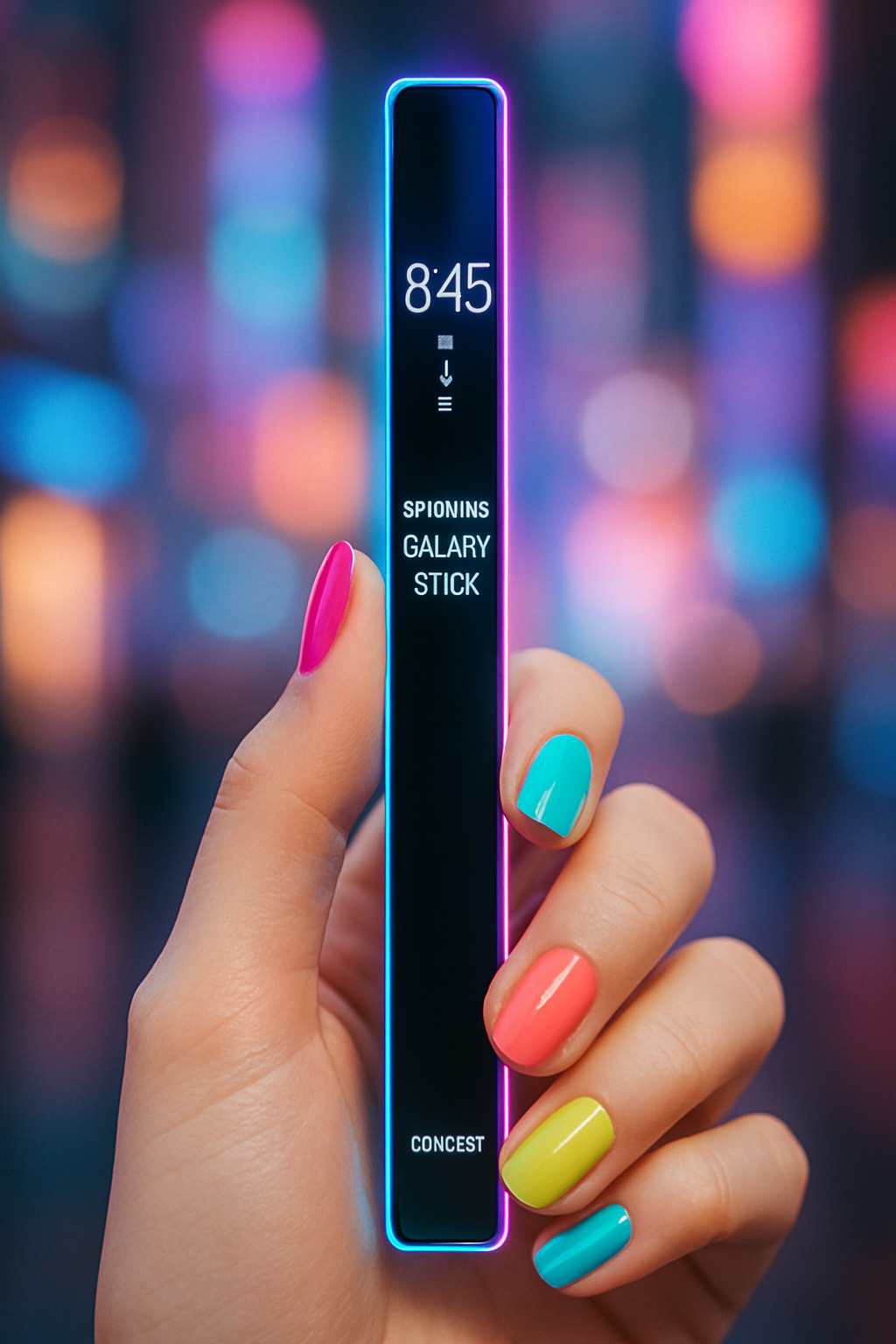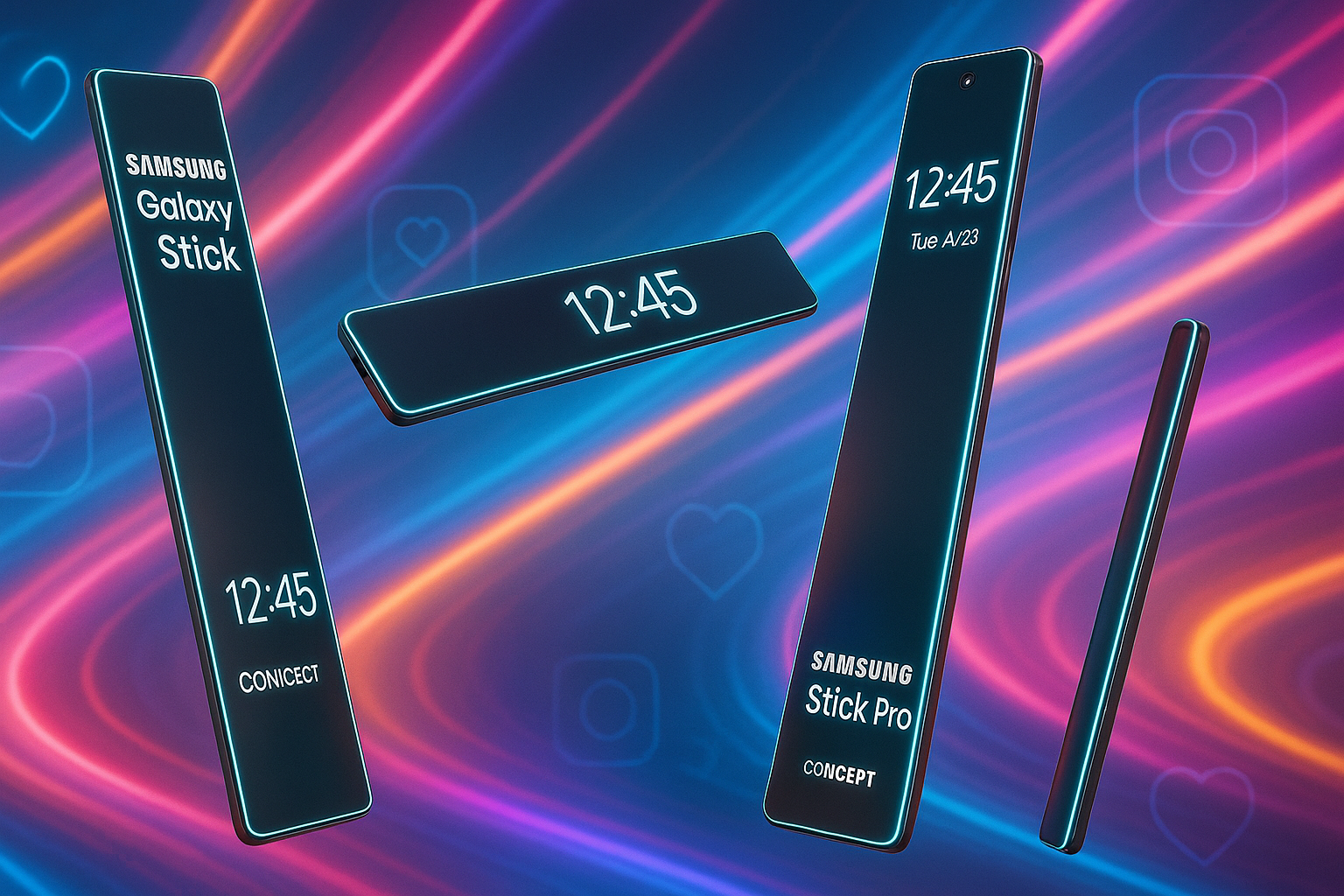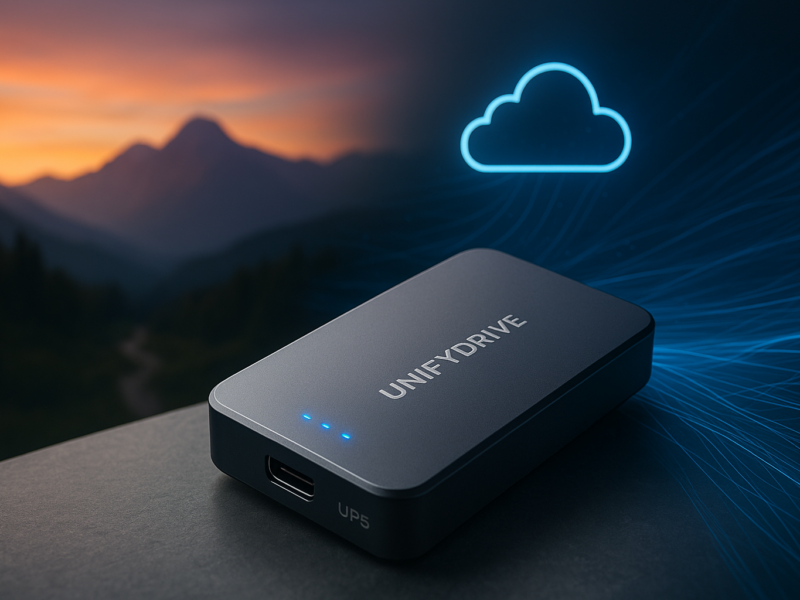Contents
- 1 Samsung Galaxy Stick & Stick Pro: Deconstructing a Gen Z Design Concept
- 1.1 1. Executive Summary: The Galaxy Stick Phenomenon – Real Product or Design Dream?
- 1.2 2. Deconstructing the Concept: A Retro-Futuristic Vision
- 1.3 3. Conceptual Specifications: Differentiating the Stick and Stick Pro (AndroidLeo Concept)
- 1.4 4. Decoding “Reinvented for Gen Z Style”: Marketing vs. Reality
- 1.5 5. Practicality and Potential: The Stick’s Double-Edged Sword
- 1.6 6. The Bottom Line: Availability and Pricing
- 1.7 7. Conclusion: The Value of Design Exploration
- 1.8 Author
Samsung Galaxy Stick & Stick Pro: Deconstructing a Gen Z Design Concept
1. Executive Summary: The Galaxy Stick Phenomenon – Real Product or Design Dream?

In the ever-evolving landscape of smartphone design, whispers and renders of novel devices frequently capture the imagination of tech enthusiasts. Recently, the “Samsung Galaxy Stick” and “Samsung Galaxy Stick Pro” have generated considerable online buzz, often positioned as radical reinterpretations of the smartphone specifically tailored for “Gen Z style”. These concepts promise a departure from conventional designs, evoking nostalgia while aiming for futuristic appeal. However, the immediate and crucial question arises: are these tangible products available for purchase, or merely speculative digital creations?
Based on a thorough analysis of available information, the conclusion is unequivocal: the Samsung Galaxy Stick and Galaxy Stick Pro are conceptual designs, not commercially available Samsung products. Extensive searches across Samsung’s official websites and major technology news outlets reveal no official announcements, product pages, or credible reviews for devices bearing these names. The discourse surrounding the Galaxy Stick originates entirely from concept phone showcases, social media platforms like TikTok and Reddit, and YouTube videos presenting renders or discussing the idea of such devices.
This report delves into the Galaxy Stick concept, dissecting its purported design philosophy, features, and the speculative differences between the standard and “Pro” versions based on the available descriptions and visual representations. It critically analyzes the claim that this design is “reinvented for Gen Z style” by contrasting its hypothetical attributes with documented Gen Z consumer trends and digital behaviors. Furthermore, the report evaluates the concept’s potential practicality and market viability, ultimately confirming its status as a design exploration rather than a market reality.
The significant online chatter and visual content surrounding the Galaxy Stick, despite its non-existence as a commercial product, illustrates a modern dynamic where conceptual designs themselves can become viral content. Platforms favored by younger audiences, like TikTok and Reddit, amplify these ideas, generating discussion and perceived interest, often treating the concepts as imminent releases. This cycle, fueled by compelling renders, might inadvertently serve as informal market research for unconventional form factors, gauging public reaction to radical ideas even if the specific concept under discussion remains impractical or purely fantastical.
2. Deconstructing the Concept: A Retro-Futuristic Vision
The core idea behind the Samsung Galaxy Stick concept appears to be a deliberate attempt to break the mold of contemporary smartphone design, often criticized as a sea of homogenous “boring glass slabs”. It positions itself as a throwback to a time when mobile phone design was more experimental and varied, citing examples like Nokia’s unconventional lipstick phone. The concept aims for a unique blend of retro charm and futuristic aesthetics, seeking to feel both familiar and revolutionary.
Physical Form Factor and Design Variants
The most striking feature of the dominant Galaxy Stick concept, attributed to designer AndroidLeo, is its ultra-narrow, elongated “stick” shape. This radical slimness defines its identity, compressing typical smartphone components into an exceptionally slender body. Despite this departure, the design retains modern elements like curved edges, suggesting an attempt to fuse past novelty with current sensibilities. While materials aren’t specified, the descriptions and renders imply a sleek, premium finish, aligning with its positioning as a potential “digital fashion accessory”.
It’s important to note that the “Galaxy Stick” name has also been applied to a distinct concept by designer Pranab P Kumar. This version features an ultra-slim stick-like body housing a retractable, flexible OLED display. The screen extends when needed and retracts for storage, prioritizing ultimate portability and potentially encouraging reduced screen time by hiding the display. This ambiguity highlights that “Galaxy Stick” may represent a category of speculative ultra-portable designs rather than a single, unified concept. The proliferation of different ideas under the same name suggests an online fascination with radically rethinking the smartphone form factor, even if these explorations remain purely conceptual.
Aesthetic Goals and Intended Impact
Both concepts, particularly the AndroidLeo version, seem to prioritize aesthetics and novelty over pure functionality. The design is explicitly framed as potentially more of a fashion statement than a practical daily driver. Its core appeal lies in its uniqueness and ability to stand out from the crowd, catering to users who value individuality in their technology. The evocation of nostalgia for past experimental designs is another key aesthetic goal. Furthermore, its unconventional appearance lends it a sci-fi quality, described as looking like something “pulled straight out of a sci-fi flick”.
3. Conceptual Specifications: Differentiating the Stick and Stick Pro (AndroidLeo Concept)
Focusing on the AndroidLeo concept, which distinguishes between a standard and Pro model, we can outline the hypothetical specifications based on the available descriptions and renders. Both envisioned devices run an Android-based user interface, maintaining the core software experience of a modern smartphone despite the radical hardware change.
Display Differences:
- Galaxy Stick (Standard): Conceptualized with a 4-inch AMOLED display. This is presented as the larger of the two options.
- Galaxy Stick Pro: Envisioned with a smaller 3-inch vertical Super AMOLED display. The “Pro” designation here paradoxically refers to the smaller, potentially less usable screen size.
- The use of AMOLED/Super AMOLED terminology suggests the concept aims for the vibrant colors and deep blacks characteristic of Samsung’s actual display technology.
Camera Setup (Conceptual Discrepancy Noted):
- Galaxy Stick (Standard): Renderings show a single rear camera.
- Galaxy Stick Pro: Renderings depict a dual rear camera setup.
- Note: There is a discrepancy in the descriptions. One source attributes a dual-camera setup to the standard model’s description, while another explicitly assigns the single camera to the standard Stick and the dual camera to the Stick Pro. This inconsistency underscores the speculative nature of the concept. A front-facing camera is implied for selfie and video call functionality, but details are absent.
Other Speculative Features:
Both models inherently feature a touchscreen interface and app-based operation. While not explicitly mentioned for the AndroidLeo concept, features like an in-screen fingerprint scanner (mentioned for the retractable concept) could theoretically be incorporated.
The table below summarizes the key conceptual differences based only on the available descriptions:
4. Decoding “Reinvented for Gen Z Style”: Marketing vs. Reality
The central marketing proposition for the Galaxy Stick concept is its specific design focus on Generation Z, aiming to appeal to their perceived values of portability, uniqueness, nostalgia, and heavy social media usage. The ultra-slim form factor aligns with a desire for convenience and perhaps minimalist aesthetics. Its radical departure from mainstream designs caters to the idea that Gen Z seeks individuality and views technology as a fashion statement. The nod to older, experimental phones taps into current Y2K nostalgia trends popular among this demographic. Furthermore, the concept explicitly targets social media influencers and TikTok creators as potential users.
However, when juxtaposed with documented Gen Z digital behaviors and preferences, the concept’s alignment with “Gen Z style” appears superficial and potentially flawed.
-
Functionality vs. Form: Gen Z are true digital natives who spend significant time online, relying heavily on smartphones for communication, information, entertainment, and commerce. They value seamless, convenient digital experiences. The Galaxy Stick concept, with its acknowledged usability challenges – particularly the “nightmare” of typing on a narrow screen – directly contradicts this fundamental need for functional efficiency. Prioritizing a novel aesthetic over the practical demands of a generation deeply integrated with their devices seems misguided.
-
Content Consumption and Creation: Gen Z’s media diet is dominated by visual content, especially short-form video on platforms like TikTok and Instagram Reels. They are not just consumers but active creators. A tiny, narrow display is inherently ill-suited for comfortably viewing, editing, or interacting with this visually rich content. While cameras are part of the concept, the awkward form factor could hinder the very social media creation activities it supposedly targets. The physical design appears counter-intuitive to the primary modes of Gen Z’s digital engagement.
-
Authenticity and Value: This generation values authenticity, transparency, and genuine value. They are adept at spotting inauthentic marketing and are skeptical of gimmicks. Marketing a purely conceptual, potentially impractical device as “reinvented for Gen Z” based on aesthetic stereotypes risks being perceived as inauthentic. Gen Z trusts peer reviews and creator recommendations, forms of validation a concept phone inherently lacks. Furthermore, Gen Z is financially conscious. A niche device with compromised usability and potential fragility would struggle to offer compelling value, especially compared to Samsung’s own A-series phones that provide robust features at accessible price points.
-
Communication Needs: Effective communication, including messaging, is vital for Gen Z’s social interactions. The anticipated typing difficulties would severely impede this core smartphone function.
This analysis suggests that the “Galaxy Stick for Gen Z” framing falls into a common marketing trap: designing for a demographic based on superficial stereotypes (unique style, nostalgia) rather than designing with their actual, nuanced needs derived from their lived digital experiences (seamless functionality, ease of content creation/consumption, authenticity, practical value). The concept prioritizes a look potentially associated with Gen Z trends over the functionality essential to their digital lifestyle.
The following table contrasts documented Gen Z preferences with the Galaxy Stick concept’s features:
5. Practicality and Potential: The Stick’s Double-Edged Sword
Beyond the marketing narrative, the practical viability of the Galaxy Stick concept faces significant hurdles, acknowledged even within the descriptions promoting it.
Usability Challenges:
- Input Methods: The primary concern revolves around text input and navigation on an extremely narrow screen. Sources describe typing as a potential “nightmare”, prompting speculation about workarounds like mandatory landscape orientation or reliance on text-to-speech. Navigating a modern, dense mobile OS on such a constrained display would likely be cumbersome.
- Hardware Limitations: The physics of miniaturization impose constraints. Fitting powerful processors, large batteries, sophisticated sensors, and adequate cooling into such a slim chassis presents a major engineering challenge. Compromises in performance, battery life, or feature set seem inevitable.
- Durability: Users discussing the concept express concerns about its potential fragility, particularly regarding drops. This contrasts sharply with the increasing focus on durability in mainstream smartphones, including Samsung’s own flagships and foldables which feature robust materials and water resistance ratings. The retractable screen variant would introduce additional mechanical complexity and potential points of failure.
Market Potential Analysis:
The concept’s radical nature makes it inherently a niche proposition. There might be a small market segment attracted to its extreme portability, unique aesthetic, or its potential use as a secondary device – a “digital fashion accessory” or a specialized “multitool” for specific tasks. Comparisons to unique historical phones like the Nokia 7380 or Haier P5 Pen Phone underscore this niche potential.
However, its prospects in the mass market appear dim. The significant usability compromises and potential hardware limitations make it unlikely to gain widespread adoption. Descriptions label it “pure fantasy” and doubt its viability as a real product.
Interestingly, the concept’s discussion within online communities focused on simpler phones points to a potential appeal based on perceived simplicity. The minimalist look might attract those seeking an escape from complex smartphones. However, the concept retains a full Android UI, creating a fundamental conflict. It attempts to run a sophisticated operating system on hardware with severely limited input and display capabilities. This awkward positioning means it likely fails to satisfy either the dumb phone enthusiast seeking genuine simplicity and ease of use, or the typical smartphone user demanding seamless functionality and power. It occupies a middle ground where it excels at neither.
Despite its impracticality, the Galaxy Stick concept serves a purpose within the broader context of smartphone innovation. Like actual experimental products (Samsung’s Z Fold/Flip series, LG’s rollable concepts, emerging tri-fold designs), it represents an exploration beyond the dominant slab form factor, pushing design boundaries and sparking conversation.

6. The Bottom Line: Availability and Pricing
To be unequivocally clear: the Samsung Galaxy Stick and Galaxy Stick Pro, as depicted in the circulating concepts and renders, do not exist as commercially available products. There have been no official announcements from Samsung, no product listings on their websites, and no reviews or hands-on impressions from reputable technology publications or reviewers.
Any mention of pricing is purely speculative user guesswork based on the concept’s appearance. One user mused about a hypothetical $100-200 price point, but this holds no basis in reality and should not be considered indicative of potential cost if such a device were ever produced (which seems unlikely). This contrasts starkly with the established pricing structures of Samsung’s actual product lines, from the budget-friendly A-series to the premium S and Z series.
Consequently, there is no market availability for the Galaxy Stick or Stick Pro. They have no release date, are not sold in any region, and are not available through any retailers. They remain firmly in the realm of conceptual design exploration.
7. Conclusion: The Value of Design Exploration
The Samsung Galaxy Stick and Stick Pro capture attention as compelling design concepts, offering a glimpse into alternative smartphone futures, but they are not tangible products available for purchase. Their defining features – an ultra-narrow, elongated form factor aiming for a retro-futuristic aesthetic – are intended to resonate with a “Gen Z style” focused on uniqueness and portability. However, this positioning appears to clash with the practical usability demands of a generation deeply reliant on functional, seamless digital experiences. Significant concerns regarding typing, navigation, hardware limitations, and durability render the concept impractical for mass-market adoption.
Despite this, the value of such conceptual explorations should not be dismissed. The Galaxy Stick serves to:
- Challenge Conventions: It forces a reconsideration of the standard smartphone shape and encourages thinking outside the “glass slab”.
- Stimulate Discussion: The online buzz demonstrates how concepts can generate engagement and potentially gauge reactions to novel ideas.
- Inspire Future Design: Even impractical concepts can contain elements or ideas that influence future, more viable products. The focus on extreme portability or unique aesthetics might find echoes in later designs.
- Showcase Possibilities: Concepts, like the retractable screen variant, can highlight emerging technologies like flexible displays.
The spirit of experimentation embodied by the Stick concept is mirrored in Samsung’s actual innovations, such as the Galaxy Z Fold and Z Flip series. These devices also challenged norms but achieved market viability through more practical execution, demonstrating that radical design shifts are possible when usability is carefully considered. The ongoing exploration of even more complex forms, like tri-fold phones, shows this drive continues.
Should Samsung, or any manufacturer, genuinely aim to create an ultra-portable or uniquely styled device targeted at younger demographics, the analysis of Gen Z preferences offers key considerations:
- Functionality First: Core usability (input, viewing, navigation) cannot be sacrificed for aesthetics.
- Seamless Integration: Smooth performance on key social and communication platforms is paramount.
- Authentic Value: Offer tangible benefits beyond novelty – perhaps a standout camera optimized for social sharing, unique software features, exceptional battery life, or strong value for money.
- Build Trust: Address durability concerns and communicate transparently, avoiding gimmicky marketing.
- Understand, Don’t Stereotype: Engage genuinely with the target audience to understand their real needs, moving beyond superficial interpretations of “style.”
In conclusion, while the Samsung Galaxy Stick remains a digital phantasm, the conversations it ignites about breaking smartphone monotony and exploring new form factors are valuable. It serves as a reminder that the future of mobile design, while needing to be practical, doesn’t have to be predictable.


